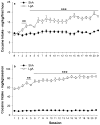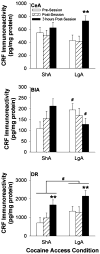Extended access cocaine self-administration differentially activates dorsal raphe and amygdala corticotropin-releasing factor systems in rats
- PMID: 21762287
- PMCID: PMC3304464
- DOI: 10.1111/j.1369-1600.2011.00329.x
Extended access cocaine self-administration differentially activates dorsal raphe and amygdala corticotropin-releasing factor systems in rats
Abstract
Cocaine-induced neuroadaptation of stress-related circuitry and increased access to cocaine each putatively contribute to the transition from cocaine use to cocaine dependence. The present study tested the hypothesis that rats receiving extended versus brief daily access to cocaine would exhibit regional differences in levels of the stress-regulatory neuropeptide corticotropin-releasing factor (CRF). A secondary goal was to explore how CRF levels change in relation to the time since cocaine self-administration. Male Wistar rats acquired operant self-administration of cocaine and were assigned to receive daily long access (6 hours/day, LgA, n=20) or short access (1 hour/day, ShA, n=18) to intravenous cocaine self-administration (fixed ratio 1, ~0.50 mg/kg/infusion). After at least 3 weeks, tissue CRF immunoreactivity was measured at one of three timepoints: pre-session, post-session or 3 hours post-session. LgA, but not ShA, rats showed increased total session and first-hour cocaine intake. CRF immunoreactivity increased within the dorsal raphe (DR) and basolateral, but not central, nucleus of the amygdala (BLA, CeA) of ShA rats from pre-session to 3 hours post-session. In LgA rats, CRF immunoreactivity increased from pre-session to 3 hours post-session within the CeA and DR but tended to decrease in the BLA. LgA rats showed higher CRF levels than ShA rats in the DR and, pre-session, in the BLA. Thus, voluntary cocaine intake engages stress-regulatory CRF systems of the DR and amygdala. Increased availability of cocaine promotes greater tissue CRF levels in these extrahypothalamic brain regions, changes associated here with a model of cocaine dependence.
© 2011 The Authors, Addiction Biology © 2011 Society for the Study of Addiction.
Figures


Similar articles
-
Median and Dorsal Raphe Serotonergic Neurons Control Moderate Versus Compulsive Cocaine Intake.Biol Psychiatry. 2018 Jun 15;83(12):1024-1035. doi: 10.1016/j.biopsych.2017.10.031. Epub 2017 Nov 20. Biol Psychiatry. 2018. PMID: 29357981 Free PMC article.
-
CRF(1) receptor antagonists attenuate escalated cocaine self-administration in rats.Psychopharmacology (Berl). 2008 Feb;196(3):473-82. doi: 10.1007/s00213-007-0983-9. Epub 2007 Oct 30. Psychopharmacology (Berl). 2008. PMID: 17965976 Free PMC article.
-
In vivo CRF release in rat amygdala is increased during cocaine withdrawal in self-administering rats.Synapse. 1999 Jun 15;32(4):254-61. doi: 10.1002/(SICI)1098-2396(19990615)32:4<254::AID-SYN2>3.0.CO;2-H. Synapse. 1999. PMID: 10332801
-
Evaluation of the relationship between anxiety during withdrawal and stress-induced reinstatement of cocaine seeking.Prog Neuropsychopharmacol Biol Psychiatry. 2010 Jun 30;34(5):798-807. doi: 10.1016/j.pnpbp.2009.11.025. Epub 2009 Dec 5. Prog Neuropsychopharmacol Biol Psychiatry. 2010. PMID: 19969038 Review.
-
Neurobiology of stress and cocaine addiction. Studies on corticotropin-releasing factor in rats, monkeys, and humans.Ann N Y Acad Sci. 1998 Jun 30;851:371-87. doi: 10.1111/j.1749-6632.1998.tb09011.x. Ann N Y Acad Sci. 1998. PMID: 9668628 Review.
Cited by
-
The role of dorsal raphe nucleus neuropeptides in reward and aversion.Front Behav Neurosci. 2025 Apr 9;19:1553470. doi: 10.3389/fnbeh.2025.1553470. eCollection 2025. Front Behav Neurosci. 2025. PMID: 40270681 Free PMC article. Review.
-
Coordinate regulation of noradrenergic and serotonergic brain regions by amygdalar neurons.J Chem Neuroanat. 2013 Sep;52:9-19. doi: 10.1016/j.jchemneu.2013.04.003. Epub 2013 May 4. J Chem Neuroanat. 2013. PMID: 23651691 Free PMC article.
-
Hypocretin Neurotransmission Within the Central Amygdala Mediates Escalated Cocaine Self-administration and Stress-Induced Reinstatement in Rats.Biol Psychiatry. 2017 Apr 1;81(7):606-615. doi: 10.1016/j.biopsych.2016.06.010. Epub 2016 Jun 16. Biol Psychiatry. 2017. PMID: 27567312 Free PMC article.
-
The duration of intermittent access to preferred sucrose-rich food affects binge-like intake, fat accumulation, and fasting glucose in male rats.Appetite. 2018 Nov 1;130:59-69. doi: 10.1016/j.appet.2018.07.025. Epub 2018 Jul 29. Appetite. 2018. PMID: 30063959 Free PMC article.
-
Knockdown of CRF1 receptors in the ventral tegmental area attenuates cue- and acute food deprivation stress-induced cocaine seeking in mice.J Neurosci. 2014 Aug 27;34(35):11560-70. doi: 10.1523/JNEUROSCI.4763-12.2014. J Neurosci. 2014. PMID: 25164654 Free PMC article.
References
-
- Ahmed SH, Kenny PJ, Koob GF, Markou A. Neurobiological evidence for hedonic allostasis associated with escalating cocaine use. Nat Neurosci. 2002;5:625–626. - PubMed
-
- Ahmed SH, Koob GF. Transition from moderate to excessive drug intake: change in hedonic set point. Science. 1998;282:298–300. - PubMed
-
- Ahmed SH, Koob GF. Long-lasting increase in the set point for cocaine self-administration after escalation in rats. Psychopharmacology (Berl) 1999;146:303–312. - PubMed
-
- Ambrosio E, Sharpe LG, Pilotte NS. Regional binding to corticotropin releasing factor receptors in brain of rats exposed to chronic cocaine and cocaine withdrawal. Synapse. 1997;25:272–276. - PubMed
-
- Aubry JM, Pozzoli G, Vale WW. Chronic treatment with the antidepressant amitriptyline decreases CRF-R1 receptor mRNA levels in the rat amygdala. Neurosci Lett. 1999;266:197–200. - PubMed
Publication types
MeSH terms
Substances
Grants and funding
LinkOut - more resources
Full Text Sources
Medical
Molecular Biology Databases

